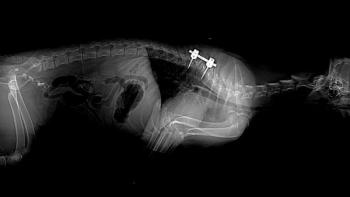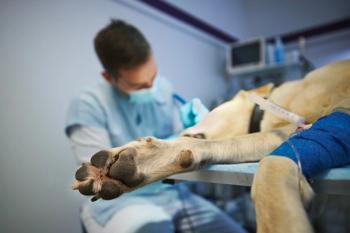
Is it neuro or ortho? Sorting out lameness, paresis and dogs that won't get up (Proceedings)
Lameness, difficulty walking, and reluctance or inability to rise are common presentations for patients presented to small animal practitioners. Disorders of the central and peripheral nervous systems, spine, long bones, joints, tendons, or musculature can all result in these potential signs.
Lameness, difficulty walking, and reluctance or inability to rise are common presentations for patients presented to small animal practitioners. Disorders of the central and peripheral nervous systems, spine, long bones, joints, tendons, or musculature can all result in these potential signs. Identifying the organ system and anatomic structures responsible are critical to recommending subsequent diagnostic testing, therapy, and possibly referral to the appropriate specialist. The most critical steps in this evaluation are careful observation of the animal's gait, and a thorough neurologic and orthopedic examination.
Gait examination
Gait examination is arguably the most important part of the evaluation of patients with difficulty ambulating, but is often not performed by veterinary practitioners. The patient should be evaluated while walking towards and away from the examiner, and should also be observed from the side. If the animal is unable to stand or bear weight, adequate support of the limbs in question should be provided while assessing the ability of the animal to voluntarily advance its limbs, bear weight, and move in a coordinated manner.
Several abnormalities may be detected with the gait examination. These include:
• Ataxia: incoordination characterized by a failure to walk or move the limbs in a straight line, crossing of the limbs over the body midline, and possibly stumbling and falling. Ataxia indicates neurologic dysfunction, and may be caused by involvement of several areas of the nervous system.
o Sensory ataxia: Lesions of the sensory nerve, spinal cord or brainstem commonly cause incoordination. Spinal cord and brainstem lesions are typically accompanied by paresis (see below).
o Cerebellar ataxia: Cerebellar lesions can cause a profound ataxia characterized by dysmetria (hypermetria and hypometria), and intention tremors. Animals with pure cerebellar lesions maintain good strength without obvious paresis.
o Vestibular ataxia: Characteristic incoordination typified by leaning, drifting, stumbling, and falling to one side. Usually accompanied by a head tilt, nystagmus, and possibly positional strabismus. Bilateral involvement of the vestibular system can lead to ataxia and bizarre, wide head excursions but without an obvious head tilt or ataxia, although loss of a normal physiologic nystagmus can often be appreciated.
• Paresis: muscular weakness. On the gait exam, this is characterized by scuffing of the nails, dragging of one or more limbs, a short-strided gait, or rapid tiring with activity/exercise. Paresis denotes dysfunction of the nervous or muscular systems.
• Lameness: Inability or reluctance to bear weight on one or more limbs. Lameness often indicates a lesion in the long bones, joints, tendons, or musculature (i.e., orthopedic), although entrapment or compression of a nerve or nerve root can also lead to lameness ("root signature").
Orthopedic examination
Orthopedic examination should include careful examination of the affected and normal limbs, evaluating the long bones, joints, tendons and musculature. Joints are palpated for evidence of effusion and pain, and flexed and extended for evidence of instability, excessive or restricted motion, and pain. Muscles are palpated to assess tone, atrophy or hypertrophy, and for evidence of pain.
Neurologic examination
A thorough neurologic examination is an important part of the evaluation of animals with gait dysfunction. Particular attention should be paid to gait examination (see above), and the assessment of postural reactions, segmental spinal reflexes, and muscular and spinal palpation.
• Postural reactions: These include tests such as proprioceptive placing ("conscious proprioception"), hopping, hemistanding, hemiwalking, wheelbarrowing, and the extensor postural thrust. A convincing postural reaction deficit indicates a lesion in the nervous system, although may have minimal localizing value beyond this, as sensory nerves, spinal cord, brainstem, thalamus, cerebral cortex, and descending motor systems are all involved in these responses.
• Segmental spinal reflexes: These include limb reflexes as well as the perineal reflex, and require sensory neurons, associated spinal cord segments, motor neurons, neuromuscular junction, and muscles to function correctly. The patellar and withdrawal reflexes are the most reliable and should probably be performed in any animal with a gait abnormality. Convincing reflex deficits indicate dysfunction of the peripheral nerves, associated spinal cord segments, or neuromuscular junction.
• Muscular Palpation: Animals that are not bearing full weight or using a limb may develop disuse atrophy of the muscles of this limb. Neurogenic atrophy is typically more severe and happens more quickly than disuse atrophy. Animals with lower motor neuron lesions (motor nerves, neuromuscular junction, or associated spinal cord segments [C6-T2 or L4-S3) may have reduced muscle tone and neurogenic atrophy.
• Spinal Palpation: Palpation of the cervical, thoracic and lumbar spine for evidence of pain or discomfort is an important part of the neurologic examination. Pain may be a sign of a lesion affecting the spine itself (e.g., diskospondylitis, vertebral neoplasia) or referred from nervous system structures (intervertebral disk disease, meningomyelitis, CNS neoplasia). Evaluation of the lumbosacral space also includes elevation of the tail and rectal palpation of the ventral surface of the disk space.
Clinical presentations
Acute lameness
Acute lameness is most often associated with orthopedic disease. Evidence of joint or soft tissue swelling or effusion, long bone fracture, or joint instability on orthopedic examination increases the index of suspicion or confirms the diagnosis. However, a neurologic etiology is possible, and is seen most often as a "root signature" secondary to nerve root compression by a herniated intervertebral disk. Neck or back pain, ataxia and paresis suggest nervous system involvement.
Chronic lameness
Chronic lameness is also most often orthopedic in nature, and the etiology is confirmed by similar means. However, neurologic etiologies can certainly lead to similar gait dysfunction. A chronic lameness (particularly involving a thoracic limb) that is unresponsive to nonsteroidal anti-inflammatory drugs (NSAIDs) should raise concern for a peripheral nerve sheath tumor.
Stiff, short-strided gait
A stiff, short-strided gait may occur in single or multiple limbs due to either pain or paresis. A number of etiologies can potentially cause this presentation, and careful orthopedic and neurologic examinations are required to sort these out.
Diagnostic Testing
Diagnostic tests chosen depend on the results of the gait, orthopedic, and neurologic examinations, index of suspicion of disease, severity of presentation, and financial constraints of the owner.
Orthopedic disease
Radiographic examination of the appendicular skeleton is a useful and relatively low cost diagnostic test to identify a number of disease processes. In some cases, advanced diagnostic imaging such as radionucleotide imaging (bone scan), computed tomography (CT), or magnetic resonance imaging (MRI) may provide additional information, and are more sensitive than survey radiography. Collection of a sample of joint fluid is usually diagnostic for polyarthritis.
Neurologic or neuromuscular disease
Survey radiographs of the spine are useful to detect diskospondylitis, intervertebral disk disease, and lytic vertebral tumors. CT and MRI are frequently used to identify spinal cord compression or inflammation secondary to intervertebral disk disease, meningomyelitis, CNS or PNS neoplasia, and vertebral tumors. Cerebrospinal fluid (CSF) analysis is used to document inflammation within the CNS. Electrodiagnostic testing (e.g., electromyography [EMG], nerve conduction velocity, repetitive nerve stimulation, spinal evoked potentials) is particularly useful in documenting evidence of peripheral nerve or neuromuscular disease, and occasionally myopathic diseases.
Therapeutic Intervention
A discussion of treatment of all of the conditions outlined in this talk is outside the scope of these proceedings. However, a few relevant points of therapy can be highlighted. Directly addressing the underlying disease process is the ideal goal of any therapeutic strategy, and may involve surgical correction (e.g., cranial cruciate ligament repair, hemilaminectomy for intervertebral disk removal) or medical therapy (e.g., immunosuppression in animals with myasthenia gravis or polyarthritis). Where correction of the underlying condition is not possible, palliation of the signs associated with the disease (often pain) is warranted.
Opiods and NSAIDS are often effective against the acute pain associated with trauma or operative interventions. NSAIDS are frequently used with chronic orthopedic conditions, and although they can provide some relief in animals with neuropathic pain, this drug class is often not the most effective in this scenario. Muscle relaxants (e.g., diazepam or methocarbamol) are useful in animals with intervertebral disk disease or neoplasia causing nerve root irritation, as much of the pain in these conditions is associated with muscle spasm. Gabapentin and pregabalin are some of the most effective drugs for neuropathic pain, and act through inhibition of voltage-gated calcium channels. Tramadol works through several different mechanisms and can be efficacious in controlling both orthopedic and neurogenic pain. Finally, the NMDA receptor antagonists ketamine and amantadine can be useful in acute and chronic scenarios respectively for the control of the "windup" phenomenon, which can lead to sustained pain or aberrant responses to typically nonpainful stimuli. A multimodal therapeutic strategy using several drugs and other interventions often works best for animals with significant pain as part of their clinical presentation.
Newsletter
From exam room tips to practice management insights, get trusted veterinary news delivered straight to your inbox—subscribe to dvm360.




